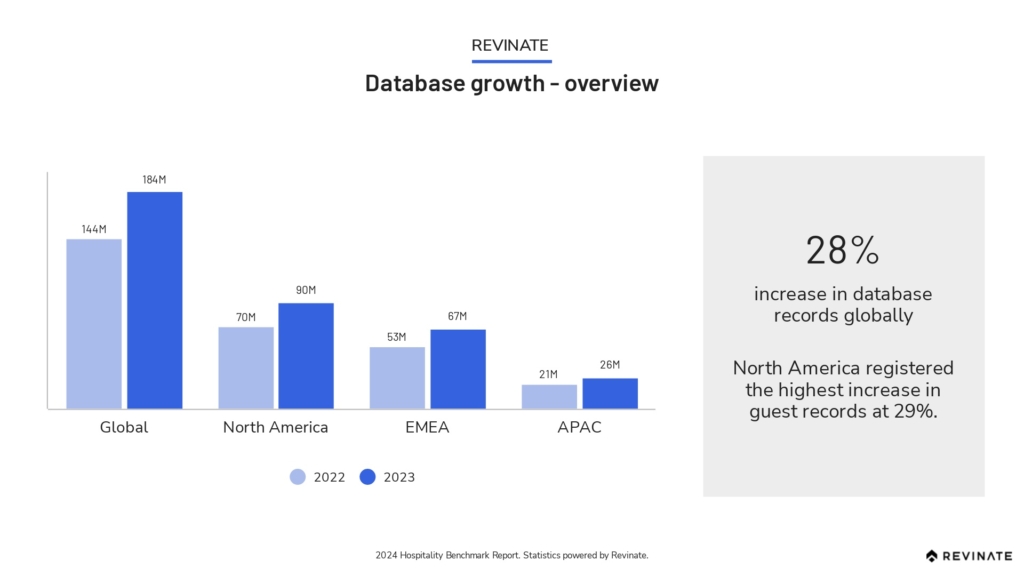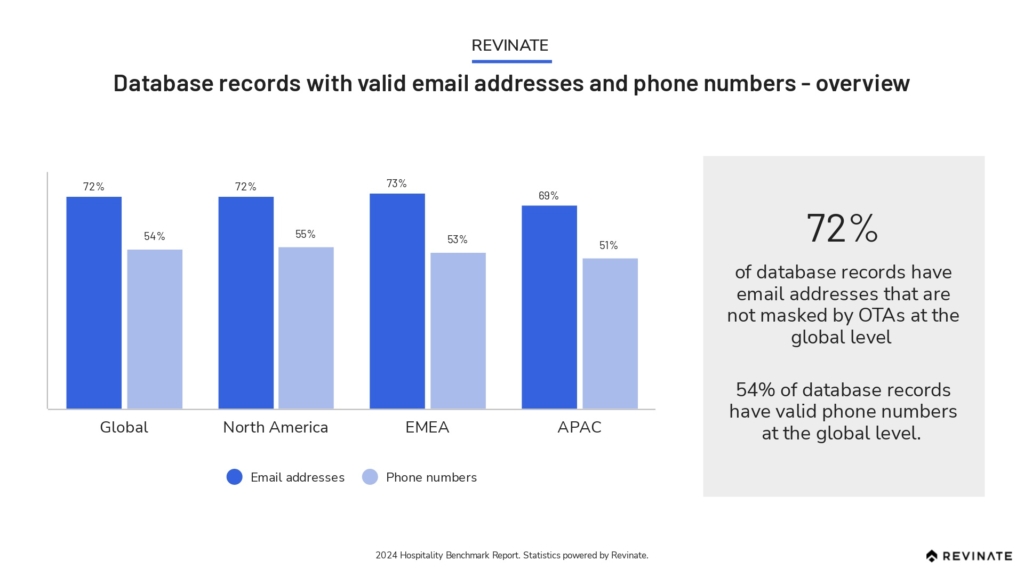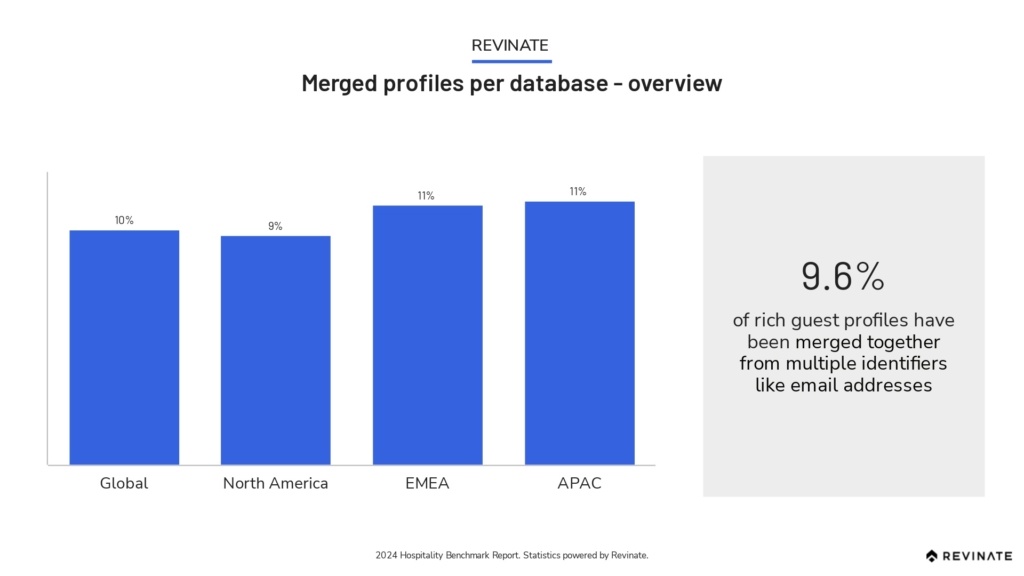Hospitality benchmarks for database health in 2024
Your hotel guest database isn’t going to tell you when it’s sick. But your marketing communications will show it. While you won’t be able to take the literal temperature of your database, but there are several indicators and industry benchmarks that can reveal the health of your database and whether it’s spiking a fever.
Database health is important to the success of your hotel’s business. It’s why 75% of organizations believe data management is important to their digital transformation efforts. How you take care of your data impacts how you communicate to guests in the digital world and in-person.
In our 2024 Hospitality Benchmark Report, we took a close look at our customers’ hotel databases — including hundreds of millions of guest records — to bring you insights to help you understand how your hotel stacks up next to your peers. Read on for key takeaways on database health.
What you will see here
What is database health?
In short, database health describes the accuracy of your customer data and how efficiently that data is being used in communication with customers. Database health affects marketing campaigns, booking calls with reservation agents, and even in-person interactions with guests at your hotel’s front desk.
Improving the quality of your data and how it’s collected is the first step towards creating a reality where you have the right information exactly when you need it to make every guest interaction personal and meaningful.
Benchmarks for a healthy database
If you’re looking to understand whether you have a healthy database, we’ve compiled global and regional benchmarks for you in our 2024 Hospitality Benchmark Report.
Here are some regional benchmarks North American hoteliers can use when it comes to their database health. Interested in exploring other regions? APAC and EMEA, we’ve got you covered.
Measurable database growth
A growing database is a good sign. It means you’re adding guest profiles, increasing your customer base, and developing a more detailed understanding of your guests. Securing a guest’s name and email is essential, but first-party data has opened up even more opportunities to gather data from your guests — revealing their preferences, booking behavior, and other characteristics that help you build a relationship with them.
2023 was a big year for North American hoteliers and growing your databases.

Not only did North American hoteliers have the highest increase in guest records (29%), but they also surpassed the global growth rate.
What’s more important than growing your database? Growing it with accurate, high-quality guest data. Because more doesn’t always mean better.
Accurate profile data: emails and phone numbers
It’s Jane Doe’s birthday! You have a personalized email, complete with a special birthday promotion for a free night and a discount on room service all scheduled and ready to go. Except, Jane never got the email on her birthday. Why? Jane’s profile listed an OTA email address.
That’s just one of the many reasons that valid email addresses and phone numbers are a crucial piece of a guest’s profile. If email communication is your primary channel for getting in touch with and marketing to your guests, or if you want to send special promos over text, you can’t afford to have missing or incomplete guest data.

In 2023, North American hoteliers met or surpassed global benchmarks for including valid email addresses and phone numbers. 56% of their database records were complete with phone numbers — more than any other region measured.
If you’re monitoring metrics like bounce rates or delivery rates for your email campaigns, not only consider that your emails could be going to spam, but consider that invalid email addresses could be to blame. In fact, your guests’ email addresses could be masked by OTAs.
It’s no surprise that guests are using OTAs to plan and book their trips, so if guests previously booked via an OTA, their email address field in your database could still harbor that OTA name. As a result, not only are these guests ineligible to receive emails from your hotel, but you could have multiple profiles of the same guests — some with and some without a masked OTA email. So how do you make sense of all the varying profiles to find the guest’s true identity? You need the right technology to identify and merge those profiles together.
Merged profile capabilities
NAM hoteliers merged 9% of their guest profiles in their database in 2023. But what does that mean, and why does it matter?

As we know, the crux of your database health lies in your guest profiles. So if you have 3 different profiles for the same person, Jane Doe, because she booked with an OTA twice and with her real email address once, then you don’t have an accurate guest profile of Jane Doe.
But if you have a Customer Data Platform, there’s a way to fix that with identity resolution. Simply put, identity resolution involves merging and de-duping guest data — combining similar profile information and correcting the mistakes to reconfigure an accurate guest profile. So if you have the right database technology to merge profile data, the more accurate your database will become.
Benefits of maintaining database health
Like with any habit, you need to stay consistent for long-term rewards. Tending to your database health follows the same principle.
Seamless segmentation and personalization
When you take care of your database, it takes care of you. Oftentimes, you may be running several campaigns at once, so nailing segmentation for every campaign can truly influence what offers your guests take advantage of.
For example, with complete, detailed, and accurate guest data, you can create a segment for a summer family vacation campaign, targeting past guests who’ve booked in July with at least two kids. Or create a “powder alert” for past guests within driving distance who have an interest in snow sports the moment the weather forecast hits. In fact, our benchmark data shows that adding three segment filters can lead to 2.6x more revenue per email recipient. And that’s only possible with a healthy guest database.
Sustainable guest loyalty
You’re seeing hundreds and thousands of guests a day, a week, a month, and they’re leaving data breadcrumbs throughout their entire guest journey. A healthy database should be constantly ingesting new data points and adding them to your rich guest profiles, so that when you need it, all that information is right at your fingertips.
From booking to check-out, a database should automatically collect guest information, so that when a guest leaves, you’ve got accurate information to keep that relationship alive. A healthy database makes it easy to reference a guest’s birthday or previous stay experience so you can reach out, re-ignite that connection, and keep them coming back for future stays. Guests notice that level of personalization and attention.
Database health is the foundation of your guest communication
Don’t ignore the signs and symptoms of an unhealthy database. Database health isn’t just about collecting data — it reflects the overall performance of your guest communication and how you’re maintaining guest connections after check-out.
If you want to see if your database health meets industry standards, access the 2024 Hospitality Benchmark Report to start improving your database management.
Related Posts

Insights that drive results
Subscribe now to get the latest content
This site is protected by reCAPTCHA and the Google Privacy Policy and Terms of Service apply. *Required fields.



